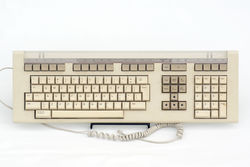DEC LK201
 | |
| Manufacturer | DEC |
|---|---|
| Layouts | 105-key DEC "ANSI Layout" (aka. VMS Layout) |
| Interface | RS423, 4800 bps |
| Introduced | 1982 |
The DEC LK201 keyboard was made by Digital Equipment Corporation (DEC) for the DEC VT-220 terminal. Several succeeding terminals and workstations from DEC were compatible with this keyboard, and there were several compatible clones from other manufacturers.
Contents
Construction
The LK201 is a membrane keyboard. Keycaps with cruciform pegs sit within a plastic assembly, and operate metal springs that press down on the membrane.[1]
Layout
The layout of the LK201 has been very influential on subsequent systems. The main typing area has what later became the ISO layout, a QWERTY keyboard with a vertical Enter key, Tab to the left of 'Q' and a '<' key to the left of 'Z'. Like its predecessor, the keyboard for the VT102, both the control and caps lock keys are to the left of 'A'. The break and delete keys were moved slightly to the right into a new group of keys, so that there was space to the right of the enter key.
Function keys are on a top row, separated into several groups. There is also a numeric keypad on the right side with four additional function keys.
The LK201 was also (one of) the first keyboards to have a compose key, which was situated to the left of the space bar.
Inverse T
The LK201 is most famous for being the keyboard that popularised the inverse-T cursor key arrangement. While the LK201 was not the first keyboard to use this arrangement, it was chosen after serious studies into usability.[2] Whether the design was independently re-invented, or copied from an earlier keyboard, is not known.
Followers
DEC, being a major player in the computing industry in the early 1980s inspired many successors with its keyboard layouts. The location of the cursor keys, the delete key and function keys were especially copied.
In 1983-1984 the IBM engineering task force developing the IBM Enhanced Keyboard (Model M) co-opted the layout of the LK201, including its signature inverted-T arrow cluster, but moved one row down.
Others layouts clearly influenced were Atari ST (1985), NEC PC-8801 (from 1986) and Amiga (from 1987). Apple copied IBM's layout with the Apple Extended Keyboard (1987).
Variants
There are many variants of the LK201 for localisation and other purposes. The keyboard code contains a two character suffix indicating the variant. For example, the LK201-AA is the USA/UK variant. There was a variant with APL keycaps, the LK201-EC.
Copies
Many keyboards copied the LK201 layout outright:
Gallery
LK201
LK201AA
References
- ↑ Soretonaku Keyboard — DEC LK201 Keyboard — keyboard disassembly (Japanese, Wayback Machine). Archived 2011-05-27.
- ↑ Jim Burrows — The Nerd Corner: Inverse-T History Last revised 2009-09-21. Retrieved 2024-03.31.
External links
- The NetBSD Project — LK201 Interface — A detailed description of the keyboard interface, pinout, etc. Retrieved 2024-03-31.
- Mark Wickens — ALLIN1 — Information about the software package. (Wayback Machine) Archived 2015-02-01.
- Mark Wickens — LK201 Pictures (Wayback Machine) Archived 2015-05-10.


















